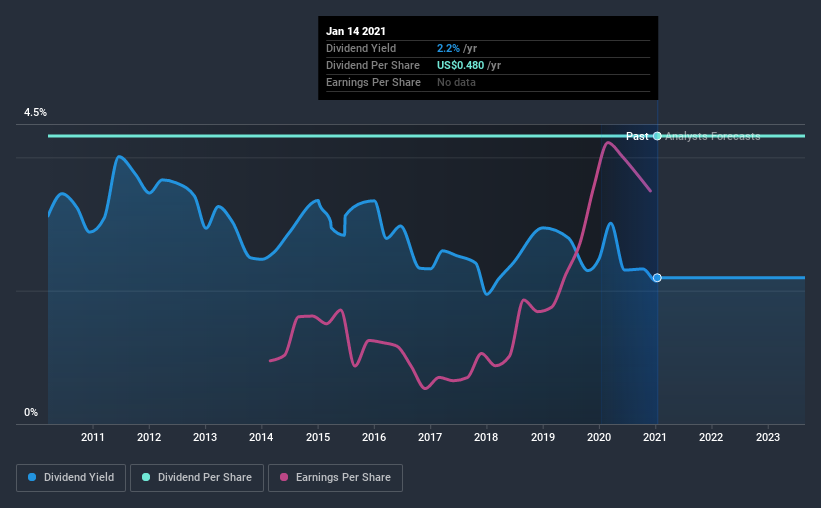Commercial Metals Company (NYSE:CMC) Looks Like A Good Stock, And It's Going Ex-Dividend Soon
Commercial Metals Company (NYSE:CMC) is about to trade ex-dividend in the next 4 days. This means that investors who purchase shares on or after the 20th of January will not receive the dividend, which will be paid on the 4th of February.
Commercial Metals's next dividend payment will be US$0.12 per share. Last year, in total, the company distributed US$0.48 to shareholders. Calculating the last year's worth of payments shows that Commercial Metals has a trailing yield of 2.2% on the current share price of $21.88. Dividends are an important source of income to many shareholders, but the health of the business is crucial to maintaining those dividends. We need to see whether the dividend is covered by earnings and if it's growing.
See our latest analysis for Commercial Metals
Dividends are typically paid out of company income, so if a company pays out more than it earned, its dividend is usually at a higher risk of being cut. Commercial Metals is paying out just 22% of its profit after tax, which is comfortably low and leaves plenty of breathing room in the case of adverse events. Yet cash flows are even more important than profits for assessing a dividend, so we need to see if the company generated enough cash to pay its distribution. What's good is that dividends were well covered by free cash flow, with the company paying out 13% of its cash flow last year.
It's encouraging to see that the dividend is covered by both profit and cash flow. This generally suggests the dividend is sustainable, as long as earnings don't drop precipitously.
Click here to see the company's payout ratio, plus analyst estimates of its future dividends.
Have Earnings And Dividends Been Growing?
Businesses with strong growth prospects usually make the best dividend payers, because it's easier to grow dividends when earnings per share are improving. If earnings decline and the company is forced to cut its dividend, investors could watch the value of their investment go up in smoke. It's encouraging to see Commercial Metals has grown its earnings rapidly, up 32% a year for the past five years. With earnings per share growing rapidly and the company sensibly reinvesting almost all of its profits within the business, Commercial Metals looks like a promising growth company.
Another key way to measure a company's dividend prospects is by measuring its historical rate of dividend growth. Commercial Metals's dividend payments are effectively flat on where they were 10 years ago.
Final Takeaway
Should investors buy Commercial Metals for the upcoming dividend? Commercial Metals has been growing earnings at a rapid rate, and has a conservatively low payout ratio, implying that it is reinvesting heavily in its business; a sterling combination. There's a lot to like about Commercial Metals, and we would prioritise taking a closer look at it.
In light of that, while Commercial Metals has an appealing dividend, it's worth knowing the risks involved with this stock. To help with this, we've discovered 2 warning signs for Commercial Metals that you should be aware of before investing in their shares.
We wouldn't recommend just buying the first dividend stock you see, though. Here's a list of interesting dividend stocks with a greater than 2% yield and an upcoming dividend.
This article by Simply Wall St is general in nature. It does not constitute a recommendation to buy or sell any stock, and does not take account of your objectives, or your financial situation. We aim to bring you long-term focused analysis driven by fundamental data. Note that our analysis may not factor in the latest price-sensitive company announcements or qualitative material. Simply Wall St has no position in any stocks mentioned.
Have feedback on this article? Concerned about the content? Get in touch with us directly. Alternatively, email editorial-team (at) simplywallst.com.

 Yahoo Finance
Yahoo Finance 
